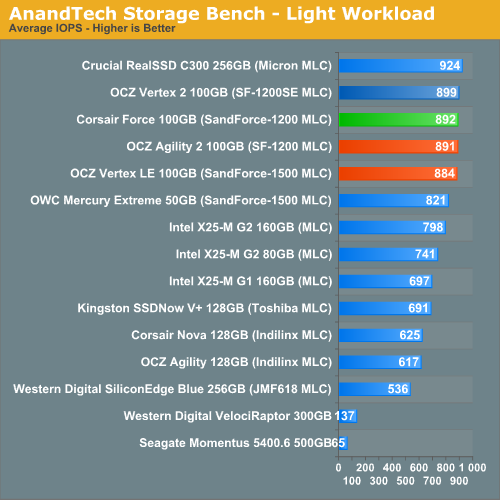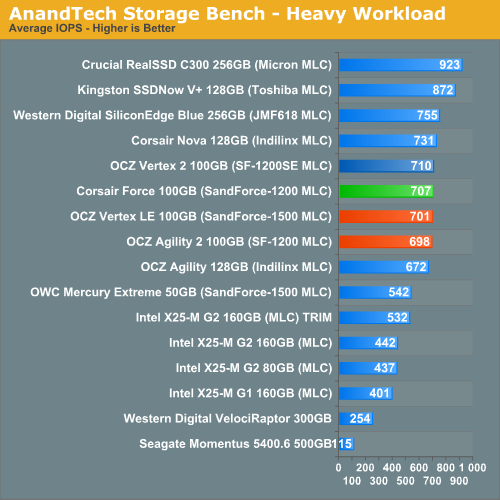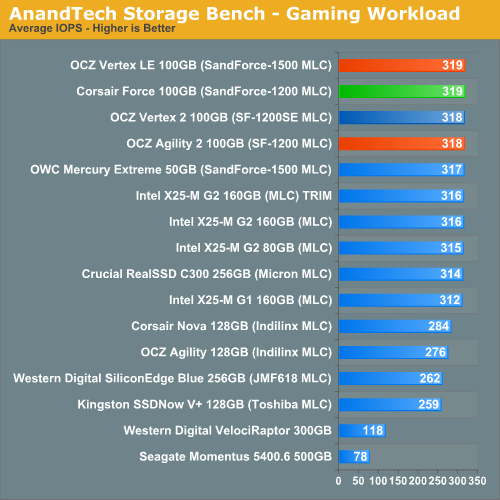OCZ's Vertex 2, Special Sauce SF-1200 Reviewed
by Anand Lal Shimpi on April 28, 2010 3:17 PM ESTAnandTech Storage Bench
Note that our 6Gbps controller driver isn't supported by our custom storage bench here, so the C300 results are only offered in 3Gbps mode.
The first in our benchmark suite is a light usage case. The Windows 7 system is loaded with Firefox, Office 2007 and Adobe Reader among other applications. With Firefox we browse web pages like Facebook, AnandTech, Digg and other sites. Outlook is also running and we use it to check emails, create and send a message with a PDF attachment. Adobe Reader is used to view some PDFs. Excel 2007 is used to create a spreadsheet, graphs and save the document. The same goes for Word 2007. We open and step through a presentation in PowerPoint 2007 received as an email attachment before saving it to the desktop. Finally we watch a bit of a Firefly episode in Windows Media Player 11.
There’s some level of multitasking going on here but it’s not unreasonable by any means. Generally the application tasks proceed linearly, with the exception of things like web browsing which may happen in between one of the other tasks.
The recording is played back on all of our drives here today. Remember that we’re isolating disk performance, all we’re doing is playing back every single disk access that happened in that ~5 minute period of usage. The light workload is composed of 37,501 reads and 20,268 writes. Over 30% of the IOs are 4KB, 11% are 16KB, 22% are 32KB and approximately 13% are 64KB in size. Less than 30% of the operations are absolutely sequential in nature. Average queue depth is 6.09 IOs.
The performance results are reported in average I/O Operations per Second (IOPS):

If there’s a light usage case there’s bound to be a heavy one. In this test we have Microsoft Security Essentials running in the background with real time virus scanning enabled. We also perform a quick scan in the middle of the test. Firefox, Outlook, Excel, Word and Powerpoint are all used the same as they were in the light test. We add Photoshop CS4 to the mix, opening a bunch of 12MP images, editing them, then saving them as highly compressed JPGs for web publishing. Windows 7’s picture viewer is used to view a bunch of pictures on the hard drive. We use 7-zip to create and extract .7z archives. Downloading is also prominently featured in our heavy test; we download large files from the Internet during portions of the benchmark, as well as use uTorrent to grab a couple of torrents. Some of the applications in use are installed during the benchmark, Windows updates are also installed. Towards the end of the test we launch World of Warcraft, play for a few minutes, then delete the folder. This test also takes into account all of the disk accesses that happen while the OS is booting.
The benchmark is 22 minutes long and it consists of 128,895 read operations and 72,411 write operations. Roughly 44% of all IOs were sequential. Approximately 30% of all accesses were 4KB in size, 12% were 16KB in size, 14% were 32KB and 20% were 64KB. Average queue depth was 3.59.

The gaming workload is made up of 75,206 read operations and only 4,592 write operations. Only 20% of the accesses are 4KB in size, nearly 40% are 64KB and 20% are 32KB. A whopping 69% of the IOs are sequential, meaning this is predominantly a sequential read benchmark. The average queue depth is 7.76 IOs.











44 Comments
View All Comments
xiphmont - Thursday, April 29, 2010 - link
Yay, good to know. Do you have any pointers to descriptions of the error handling in other drives and devices?jimhsu - Thursday, April 29, 2010 - link
Some hard numbers:Flash memory: 10^-8 to 10^-6 depending on # of cycles. Figure 2, when writing to MLC.
http://ieeexplore.ieee.org/iel5/4550747/4558854/04...
Hard drives: > 10^-4 (!!)
http://download.microsoft.com/download/a/f/d/afdfd...
And people say flash memory is unreliable. ALL consumer storage devices (hard drives, SSDs, CDs, etc) have ridiculously massive amounts of error correction considering the rate of raw errors. It just so happens that the storage media that everyone in the world uses (DNA) is the same.
MrBabbage - Wednesday, April 28, 2010 - link
Impressive benchmark numbers, but is this drive really any faster than the original Vertex (assuming you're running Windows 7, and FW 1.5)?From what I hear, you might shave a second or two off of application loading versus the original Vertex - and that's only with heavy duty applications like Photoshop and AutoCAD. Can you confirm that?
If that's the case, then this would seem to have been a step in the wrong direction: minimal performance gains for lost capacity and higher cost per gig. I still agree that SSDs are the single best performance upgrade you can buy at the moment, but with the amazing prices on Vertexes and X25-M G2s at the moment, why go for the Vertex 2? Nothing in this article suggests it's actually a good buy.
In short, benchmarking the drive's sequential read/write performance and random read/write performance is generally pretty useless. With a controller that is architected this way, it would strike me as worse than useless, given that such benchmarks will produce staggering figures that have little effect on the main uses for SSDs (faster boot times, faster application loading times, better performance with encrypted/compressed files and workloads).
strikeback03 - Thursday, April 29, 2010 - link
That is a question I wondered about in articles like this or the RAIDed 40GB Intel SSD one. Sure they turn out higher IOPS numbers, but is this something actually noticeable to humans? In a blind test would I be able to tell the difference between otherwise identical systems if one was running an 80GB X25M and one was running the RAIDed 40GB X25Vs?QChronoD - Wednesday, April 28, 2010 - link
If you wrote mostly highly compressable data to the drive, would you be able to write more "data" to this drive than a regular SSD?strikeback03 - Thursday, April 29, 2010 - link
No, as far as the OS is concerned you do not gain space by compressing the data.hybrid2d4x4 - Wednesday, April 28, 2010 - link
Anand, I don't know if you follow other sites' articles, but a fairly recent SSD roundup at Tom's also measured power consumption (see link at the bottom of the post), and curiously, they measured 0.1W idle for the Intel drive compared to similar numbers to yours for every other SSD. Are there some test system settings that might be tweaked to get such low idle power figures with the Intel drive (and others) or does it seem like there is something sketchy about their data?I know that with these low power levels, this might seem like splitting hairs, but on a CULV laptop's power budget, 0.5W is still significant, IMO. Also, is there any chance you can throw in a modern 2.5" mechanical drive as a reference point in your SSD power charts? Thanks and keep up the good work on your SSD coverage!
http://www.tomshardware.com/reviews/6gb-s-ssd-hdd,...
strikeback03 - Thursday, April 29, 2010 - link
I know the 200GB 7200 RPM drive I used in my carputer was rated for 1A at 5V. That was the only power number listed, no 12V draw.gfody - Wednesday, April 28, 2010 - link
You made a point to show iometer results using random data but you still present screenshots of HDTach's results using all-zero reads/writes. The all-zero tests are no more realistic than the iometer all-random tests - I think the all-random test is probably closer to reality than HDTach now. I may not always write perfectly random data but I certainly won't be writing all-zero data!xiphmont - Wednesday, April 28, 2010 - link
I believe that OCZ has also released and is recommending the 3.0.5 MP firmware update for the Vertex LE (It is labelled 1.0.5 on the OCZ site). Given that users were bricking their Vertex LEs left and right due to suspend bugs, this is most welcome... Anand, do you happen to know if OCZ 1.0.5 and Sandforce 3.0.5 are the same, and if the Special Sauce is preserved in the Vertex LE with this upgrade? It's been asked on the OCZ forums, but not answered directly.I have a pair of LEs that I'm going to update regardless, but it would be nice to know.